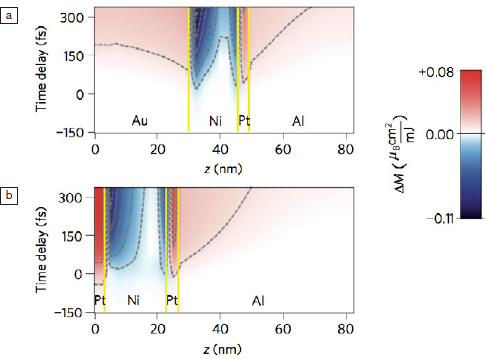The mechanics of laser-induced demagnetization has attracted considerable attention in efforts to develop fast-switching optomagnetic logic devices. A femtosecond laser pulse for instance can demagnetize a ferromagnet within a few hundred femtoseconds. Various theories have been proposed to explain how an ultrafast laser pulse can demagnetize a magnetic thin film, ranging from indirect spin-flip scattering to direct laser-induced spin flips. Now, A. Eschenlohr, M. Battiato, and colleagues at Helmholtz Zentrum Berlin and Uppsala University propose that a novel mechanism of superdiffusive electron transport drives the demagnetization.
In the January 27 online edition of Nature Materials (DOI: 10.1038/NMAT3546,) the researchers describe a unique pump-probe study to explore magnetization dynamics in Ni films. They first deposited Au/Ni/Pt/Al and Pt/Ni/Pt/Al multilayers using magnetron sputtering. The former film was grown with a Au capping layer thick enough to absorb almost all the laser light, while the latter features a very thin Pt capping layer. The top layer of the samples was irradiated with a 50 fs laser pulse and the Ni magnetization was measured in a pump-probe fashion using x-ray magnetic circular dichroism (XMCD) to probe the Ni response element-selectively.

Schematic of the temporal dependence (vertical axis) and spatial dependence (horizontal axis) change of magnetization (color) in the (a) Au/Ni and (b) Pt/Ni films. Spin-minority carriers (blue) remain trapped in the Ni layer, while the spin-majority carriers (red) are conducted to the substrate. The two samples behave similarly, demonstrating that direct optical excitation is not a requirement for the demagnetization process to occur. Reproduced with permission from Nature Mater. (DOI: 10.1038/NMAT3546). © 2013 Macmillan Publishers Ltd.
The results were modeled using superdiffusive transport theory, which allowed the researchers to extract the spatial and temporal dependence of magnetization in each sample. The results show that in the Au / Ni sample, the spin-majority electrons are mostly conducted from the Ni to the substrate and the Au cap, while spin-minority electrons remain largely trapped in the Ni layer. This leads to a very efficient and ultrafast demagnetization of the Ni layer, which is almost as fast as the response of the Pt/Ni sample measured in parallel.
From these results, the researchers conclude that direct optical excitation does not need to occur for the demagnetization process to take place. This also precludes spin flips as the dominant mechanism for demagnetization, at least for the Au/Ni structure.
The researchers conclude that the model of laser-induced spin transport best describes their demagnetization process. This new understanding may help scientists design a new generation of ultrafast optomagnetic memory materials.


